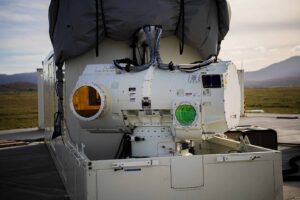The UK’s Defence Science and Technology Laboratory (Dstl) recently announced a groundbreaking achievement in defense technology with the successful test firing of the DragonFire high energy laser weapon. Developed in collaboration with industry partners Leonardo, MBDA, and QinetiQ, the trial at the Hebrides test range in northwest Scotland demonstrated the weapon’s ability to engage aerial targets, a first for the UK.
The DragonFire laser directed energy weapon (LDEW) system, a £30 million technology demonstrator program initiated in 2017, represents a major step forward in directed energy weapon technology. Its successful test marks the UK’s entry into an elite group of nations developing state-of-the-art laser systems. The DragonFire is designed as a line-of-sight weapon with a classified range but is known for its pinpoint accuracy, capable of hitting a £1 coin from a kilometer away.
This laser system’s operational cost is notably low, typically less than £10 ($13) per shot, which is a fraction of the cost of traditional missile systems. This cost-effectiveness is particularly significant given the increasing use of inexpensive but effective drones in various conflict zones. The recent trials have confirmed DragonFire’s ability to track and engage high-end targets at range, with the potential for deployment within the next 5 to 10 years.
DragonFire’s development is part of a larger £100 million joint investment by the MoD and industry to advance directed-energy weapons, including radio-frequency direct-energy weapons. The weapon’s latest trial builds on a series of successful tests, including the first static high-power laser firing of a UK-made capability and the demonstration of DragonFire’s ability to track moving air and sea targets with high accuracy.

The British Army and the Royal Navy are both interested in utilizing this technology for air defense. Plans are in place to retrofit a 150-kilowatt-class laser directed-energy weapon for new Type 26 frigates beginning in the early 2030s. The precise capabilities of DragonFire, such as its range and power levels, remain classified, but it is known as a line-of-sight weapon that can engage any visible target.
DragonFire’s successful test is not just a technological triumph but also a strategic advancement, considering the increasing threat posed by small aerial targets like kamikaze drones and loitering munitions. This development highlights the UK’s proactive approach to countering such threats and maintaining its edge in modern warfare
Best Coverage:






